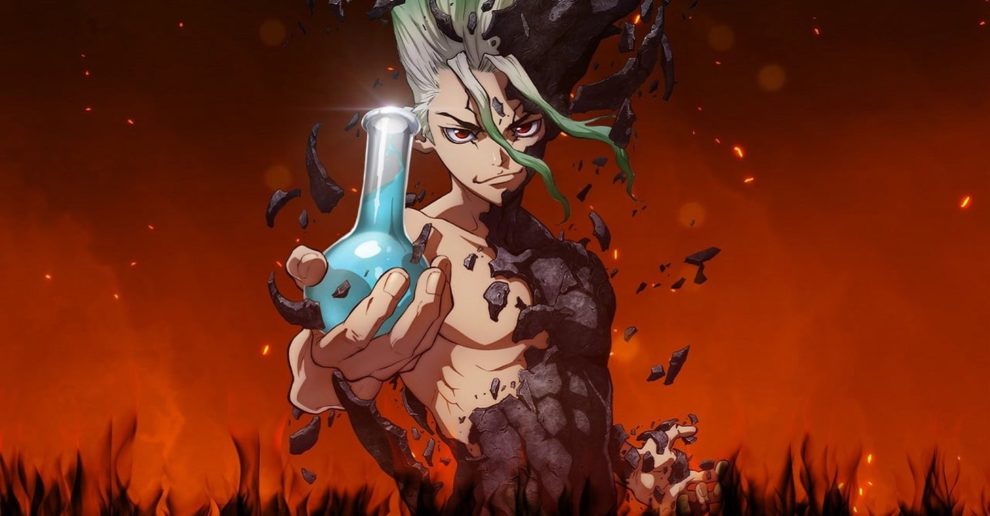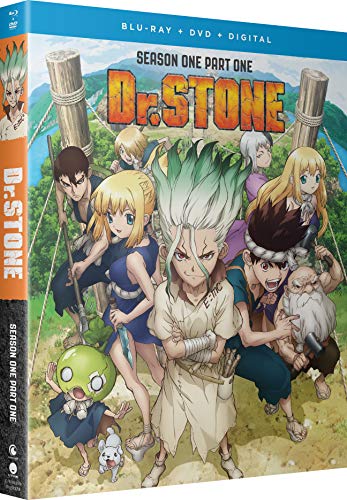Based on the manga by writer Riichiro Inagaki and illustrator Boichi, “Dr. Stone” is a title that tries to reinvigorate the shonen genre, by taking a completely different approach to whole concept.
Buy This Title
Beginning in April 5738 A.D., it's been over 3,700 years since a mysterious flash of light petrified nearly all human life. A 16-year-old genius named Senkū Ishigami is suddenly revived to find himself in a world where all traces of human civilization have been eroded by time. Senku sets up a base-camp and begins to study the petrified humans in order to determine the cause of the event, as well as a cure for the rest of the humans that are still in the stone form. Soon, he finds that nitric acid that drips from a cave can be made into a compound that instantly de-petrifies others. He begins by curing his best friend and sidekick Taiju Oki, who was about to confess his love to their classmate Yuzuriha Ogawa when the incident happen, with the girl being revived soon after. The physical power and dedication of Taiju become the perfect complement to Senku's genius, although at some point, the two of them are forced to revive Tsukasa Shishio, the strongest high schooler in Japan, in order to survive from the attacks of the beasts that roam the forest they live in. Soon, however, Tsukasa reveals that he opposes Senku's idea of forming a new scientific civilization, believing the old world was tainted and should not be restored. Instead, he desires to establish a new world order based on power and strength, going so far as to destroy any petrified adults he encounters in order to prevent them from interfering with his goals.
The clash is inevitable, but Senku eventually discovers a village of survivors, although his efforts to “enlist” them prove much more difficult than he imagined. The power of science proves invaluable but the question remains of if it is enough to counter Tsukasa's growing strength. Meanwhile, Kohaku, a girl who is also the village's strongest fighter, Chrome, an aspiring scientist, Suika, a little girl who wears a watermelon in her head constantly, and Gen Asagiri, a mentalist with doubtful dedication who was recently revived, also play a crucial role in the story.
“Dr Stone” may feature some of the trademarks of the shonen category, like the presence of the tournament, the occasionally slapstick/childish humor, the parallel rise in power of two rivals, the many and quite powerful characters coming to light, but essentially, it could not be further off from a cliché of the category. To begin with, the narrative initially focuses on what is civilization and how humanity achieved it (or has to re-achieve it in this case). This aspect, apart from philosophical, also becomes sociopolitical, as the two main rivals represent power, and in essence fascism and fundamentalism (Tsukasa) and intelligence, science, democracy and in essence capitalism (Senku). The fact that the first attracts fighters and the second workers also moves in that direction, with the clash becoming more complicated as time passes.
At the same time, the series functions much like an educational program, since Senku uses chemistry, physics and geology in order to achieve the “miracles” humanity spent millenniums conquering in just a few years. This “bringing modern civilization to the Stone Age” concept is where the title truly thrives, with the educational aspect also extending to actual “lessons” about the concept of trial and error, dealing with mistakes, and avoiding easy solutions. The actual images of Senku's achievements that are presented in the episodes' mid-break also work quite well in the narrative. On the other hand, particularly in the middle of the season, this aspect gets a bit overboard, not just for the highly unlikely way Senku manages to achieve his miraculous goals, but also on the amount of episodes the story spends on this aspect, which, at times, seems like a purely educational program with some dystopian elements here and there. This however, is soon toned down, and by no means does it ruin the overall impressive sense the title leaves, apart from a few moments.
The art form is also a bit unusual, particularly in Yuuko Iwasa's character design, which seems to present the protagonists mostly through intense close-ups to their faces, and not from some distance, as is usually the case in anime. This creates a sense that the characters are very close to the viewer, but at the same time, strips their faces from detail. On the other hand, the many individuals that appear are quite different in appearance, with Iwasa taking full advantage of the fact that a primitive and an advanced civilization co-exist after a point.
The animation by 8 Pan and TMS Entertainment is impressive, with the exception of the omnipresent, ridiculously extreme changes of faces all characters exhibit. The movement is quite realistic, the background impressive and the presentation of science, and the many stoned people captivating. The coloring on the other hand points towards a title that is mostly addressed to children, with the essence actually permeating the whole narrative on occasion, particularly in the “village arc”. Violence is toned down, as is action in general, but the few moments it appears are also enjoyable to watch at, while the ending of the season definitely leaves a “promise” of more in that regard.
“Dr. Stone” is not exactly a mature-audience oriented title, but the original story and the many unique elements of the narrative make it a title that truly stands out.
















